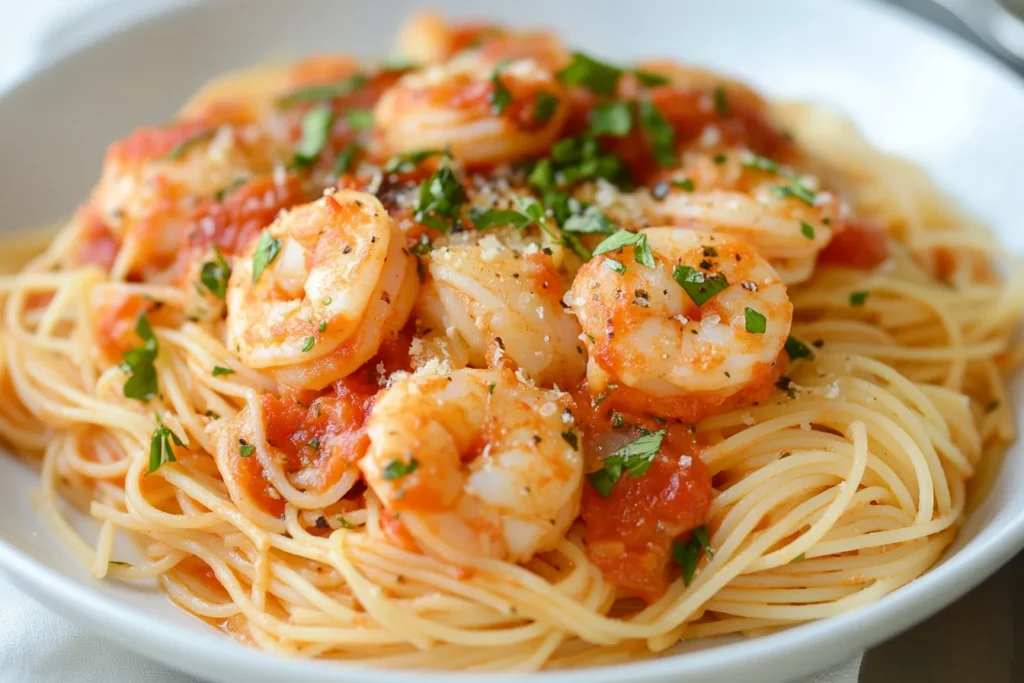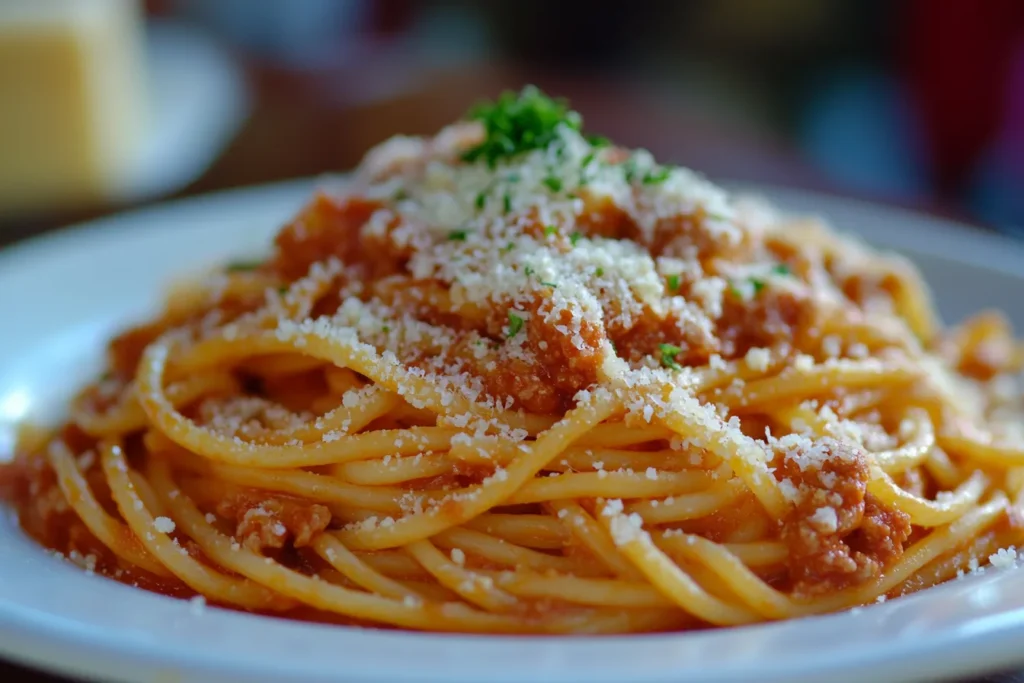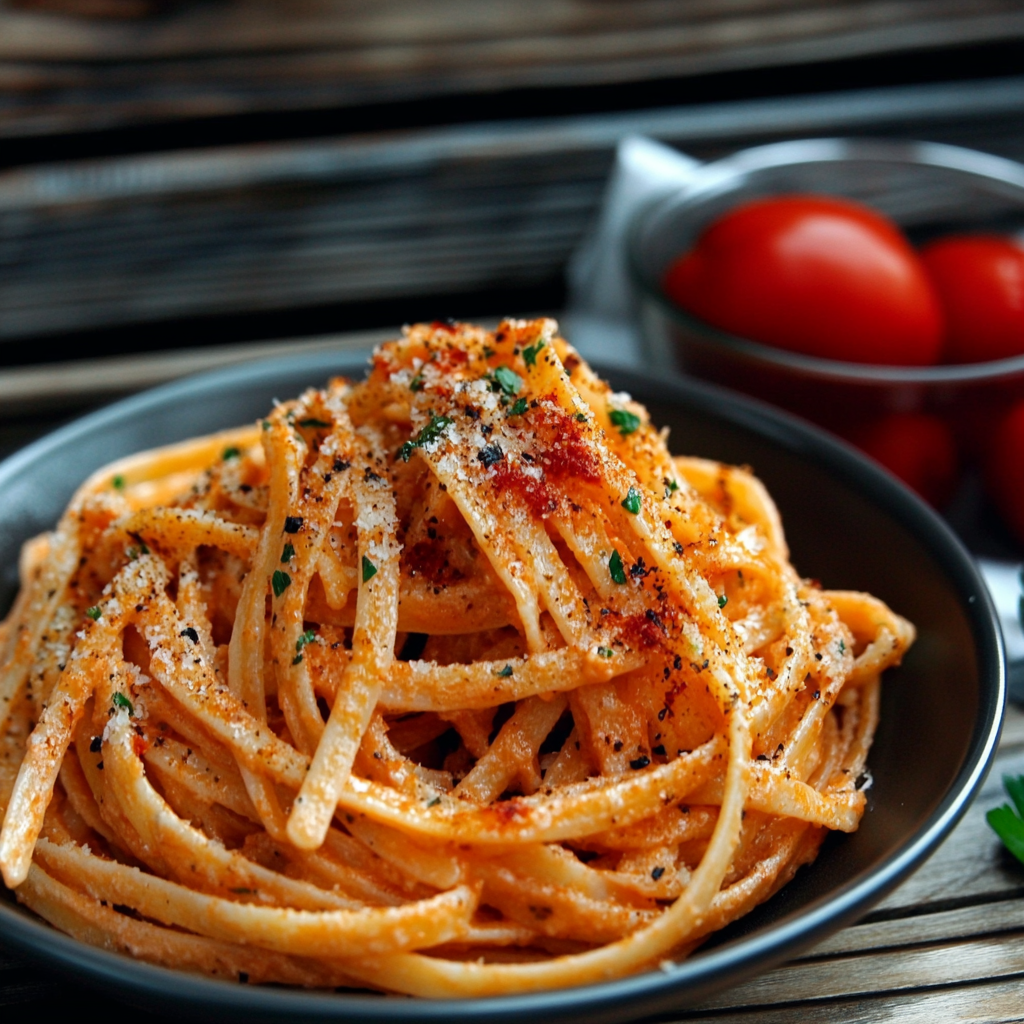Introduction to Vegetarian Spaghetti Pasta Recipes
Vegetarian spaghetti pasta recipes are a delightful way to enjoy a healthy, flavorful meal that is both versatile and satisfying. Whether you’re a seasoned vegetarian, a flexitarian, or just looking to add more plant-based meals to your diet, vegetarian pasta dishes offer endless possibilities for creativity in the kitchen. Moreover, these dishes are ideal for those who prioritize sustainability, as they typically have a lower environmental impact than meat-based meals.
Packed with vibrant vegetables, protein-rich alternatives, and an array of sauces, vegetarian spaghetti is a staple that anyone can master. Therefore, this guide explores not only the nutritional benefits of vegetarian pasta but also the techniques and tips required to make the perfect dish. By the end, you’ll have all the tools to create a variety of delicious, plant-based meals.
Why Choose Vegetarian Spaghetti Pasta recipes?
Embracing vegetarian spaghetti pasta is not just a dietary choice; it’s a lifestyle move towards sustainability, better health, and culinary exploration. For instance, plant-based pasta recipes can incorporate seasonal produce and reduce your carbon footprint at the same time.
- Environmentally friendly: Plant-based meals have a lower carbon footprint compared to meat-based dishes.
- Health benefits: Vegetarian pasta dishes are often rich in vitamins, fiber, and antioxidants while being lower in cholesterol and saturated fat.
- Adaptability: Vegetarian spaghetti is suitable for various diets, including vegan, gluten-free, and low-calorie options.
Furthermore, this versatile dish allows you to experiment with global flavors and cuisines. Consequently, you can enjoy the satisfaction of preparing something both creative and nutritious. In addition, the variety of ingredients available ensures that you never get bored with vegetarian spaghetti.le, from earthy mushrooms to zesty tomato-based sauces, vegetarian spaghetti pasta ensures there’s something for everyone.

Nutritional Benefits of Vegetarian Spaghetti Pasta
A well-prepared vegetarian spaghetti dish is a nutritional powerhouse. In particular, it offers an excellent combination of carbohydrates, vitamins, and plant-based proteins. Let’s break it down:
- High in fiber: Ingredients like whole wheat pasta, vegetables, and legumes contribute to better digestion. As a result, your meal becomes more satiating.
- Rich in vitamins and minerals: Leafy greens, tomatoes, and bell peppers provide essential nutrients such as Vitamin C, Vitamin K, and potassium. Moreover, they add vibrant colors and textures to your dish.
- Protein-packed: By incorporating plant-based proteins like lentils, chickpeas, or tofu, you can meet your daily protein requirements. Therefore, these additions make vegetarian spaghetti a balanced and complete meal.
- Heart-healthy fats: Olive oil, nuts, and avocado in pasta recipes provide essential monounsaturated fats. Additionally, they enhance the flavor and texture of the dish.
Choosing nutrient-dense ingredients not only improves the taste but also elevates the nutritional value of your vegetarian pasta.n pasta, making it both delicious and nourishing.
EEssential Ingredients for Vegetarian Pasta Recipes
The success of your vegetarian spaghetti lies in using fresh, high-quality ingredients. Therefore, it’s essential to stock up on the right staples before you start cooking. Here’s a list of must-haves:
- Pasta: Whole wheat, gluten-free, or regular spaghetti varieties.
- Vegetables: Zucchini, bell peppers, cherry tomatoes, mushrooms, and spinach.
- Sauces: Classic marinara, creamy Alfredo, or zesty pesto. Furthermore, homemade sauces can elevate the flavor of your pasta significantly.
- Herbs and spices: Basil, oregano, garlic, and red pepper flakes for that signature Italian flavor.
- Plant-based proteins: Lentils, chickpeas, tofu, or tempeh.
- Extras: Nuts, seeds, and cheeses (or vegan alternatives) for added texture and flavor.
For example, freshly picked herbs and organic produce make a significant difference in taste and nutritional value. Consequently, your pasta dish will taste as if it came straight from an Italian trattoria.ence in taste and nutritional value.
Choosing the Right Spaghetti for Your Recipe
Selecting the right type of spaghetti is essential for both the texture and taste of your dish. For instance, the type of pasta you choose can greatly influence the outcome of your recipe. In contrast, using the wrong type might leave the dish either too soft or not complementary to the sauce. Here’s a quick guide to help you decide.
Whole Wheat, Gluten-Free, or Regular Spaghetti?
Each type of spaghetti has its unique characteristics. For example, whole wheat spaghetti offers a nuttier flavor and a higher fiber content, making it a healthier option. On the other hand, gluten-free spaghetti caters to dietary needs and works best for those with gluten sensitivities or celiac disease. Meanwhile, regular spaghetti is a classic choice that pairs well with most sauces and is suitable for all palates.
As a result, understanding your preferences and dietary requirements will help you pick the perfect spaghetti. Moreover, experimenting with different varieties can introduce you to exciting new textures and flavors.
Best Brands of Vegetarian-Friendly Pasta
Additionally, the quality of the brand you choose plays an important role in the taste and texture of your spaghetti. Some top-rated options include:
- Barilla: Known for its wide range of options, including gluten-free and whole grain varieties.
- Banza: Made from chickpeas, this brand offers higher protein and fiber content, making it an excellent choice for plant-based eaters.
- De Cecco: A premium option for authentic Italian flavor and texture.
Thus, selecting a reliable brand ensures your pasta will cook evenly and taste exceptional every time.
Tools and Equipment for Cooking Perfect Pasta
Achieving al dente perfection requires the right tools. Here are some essentials:
Pasta Pots, Strainers, and Slicers: A Quick Guide
- Pasta pot with strainer: Simplifies draining and ensures even cooking.
- Vegetable slicers: For creating thin, uniform slices of zucchini, carrots, or mushrooms.
- Garlic press: Enhances flavors effortlessly.
Having these tools handy not only saves time but also elevates the quality of your dish.
Tips to Avoid Overcooking Your Spaghetti
Overcooking can ruin even the best recipes. Here’s how to avoid it:
- Always follow package instructions for cooking time.
- Salt the water generously to enhance the pasta’s flavor.
- Drain the pasta a minute early if it will be cooked further with the sauce.
Perfectly cooked spaghetti provides the ideal foundation for a memorable vegetarian meal.
Popular Vegetarian Spaghetti Recipes
Classic Vegetarian Spaghetti with Tomato Sauce
Nothing beats the timeless classic vegetarian spaghetti with tomato sauce. This dish is a crowd-pleaser, combining the simplicity of ripe tomatoes, aromatic herbs, and perfectly cooked spaghetti. Here’s how to perfect it:
Ingredients:
- Fresh tomatoes or canned crushed tomatoes
- Garlic and onions
- Olive oil
- Fresh basil, oregano, and red pepper flakes
- Whole wheat or regular spaghetti
Preparation Steps:
- Sauté garlic and onions in olive oil until fragrant.
- Add crushed tomatoes and simmer until thickened.
- Season with fresh herbs, red pepper flakes, salt, and pepper.
- Toss the sauce with al dente spaghetti and garnish with basil leaves.
For an elevated flavor, try roasting the tomatoes before blending. This recipe is a perfect entry point for beginners, offering both comfort and nutrition.
Making the Perfect Tomato Sauce from Scratch
The secret to an authentic Italian tomato sauce lies in its preparation. Here’s a foolproof way to make it from scratch:
- Choose high-quality tomatoes: San Marzano tomatoes are a favorite for their natural sweetness and low acidity.
- Add depth with aromatics: Use garlic, onions, and carrots to enhance flavor.
- Simmer low and slow: Allow the sauce to cook for at least 30 minutes for a rich, concentrated flavor.
- Finish with fresh herbs: Basil and parsley add the final touch of freshness.
Homemade tomato sauce is the backbone of many vegetarian spaghetti recipes, providing a robust base for various toppings and proteins.
Spaghetti Aglio e Olio: A Simple Vegan Delight
For lovers of simplicity, spaghetti aglio e olio is the ultimate minimalist recipe. With just a few ingredients, this dish is a testament to the beauty of Italian cooking.
Ingredients:
- Garlic (lots of it!)
- Olive oil
- Red pepper flakes
- Parsley (optional)
- Spaghetti
Preparation:
- Cook Vegetarian Spaghetti until al dente.
- Sauté thinly sliced garlic in olive oil until golden (be careful not to burn it).
- Add red pepper flakes for a spicy kick.
- Toss the Vegetarian Spaghetti Pasta recipes in the garlic-infused oil and garnish with parsley.
This vegan-friendly recipe is quick, budget-friendly, and bursting with flavor.
Creamy Spinach and Mushroom Vegetarian Spaghetti
Indulge in the luxurious textures of creamy spinach and mushroom spaghetti. This recipe strikes the perfect balance between decadence and nutrition.
Dairy-Free Options for Creamy Sauces:
- Use coconut milk or cashew cream for a velvety, dairy-free base.
- Blend soaked cashews with vegetable broth and nutritional yeast for a cheesy flavor.
Preparation Steps:
- Sauté mushrooms and spinach in olive oil with garlic and shallots.
- Stir in your creamy base (e.g., coconut milk or cashew cream).
- Add cooked spaghetti and toss until evenly coated.
- Top with toasted breadcrumbs for added texture.
This dish is ideal for a comforting dinner and pairs beautifully with a glass of white wine.
Mediterranean-Style Spaghetti with Olives and Capers
Mediterranean flavors bring a unique twist to vegetarian spaghetti. This recipe features bold, tangy notes from olives and capers.
Key Ingredients:
- Kalamata olives
- Capers
- Sun-dried tomatoes
- Fresh parsley and lemon zest
Preparation:
- Sauté garlic in olive oil and add chopped olives, capers, and sun-dried tomatoes.
- Toss the mixture with spaghetti and finish with lemon zest and parsley.
- Optional: Add crumbled feta cheese or vegan alternatives for extra creaminess.
This vibrant dish is packed with antioxidants and perfect for summer evenings.
Spaghetti Primavera: A Celebration of Fresh Vegetables
Spaghetti Primavera is a versatile dish that highlights the freshness of seasonal vegetables. It’s colorful, light, and bursting with flavor.
Seasonal Vegetables to Enhance Flavor:
- Spring: Asparagus, peas, and zucchini
- Summer: Bell peppers, cherry tomatoes, and corn
- Fall/Winter: Broccoli, carrots, and squash
Preparation:
- Sauté your chosen vegetables in olive oil with garlic.
- Add cooked spaghetti and a splash of vegetable broth or white wine.
- Season with salt, pepper, and fresh herbs.
This recipe celebrates the beauty of nature’s bounty and is customizable for any time of year.
Spaghetti Pesto: Basil, Walnut, or Vegan Variations
Pesto is a beloved sauce that elevates vegetarian spaghetti to gourmet status. While traditional basil pesto is a favorite, there are exciting variations to explore.
Variations:
- Classic Basil Pesto: Blend basil, pine nuts, garlic, Parmesan (or vegan cheese), and olive oil.
- Walnut Pesto: Use walnuts instead of pine nuts for a rich, nutty flavor.
- Vegan Pesto: Replace cheese with nutritional yeast and add avocado for creaminess.
Serving Tips:
- Toss spaghetti with freshly made pesto and a splash of pasta water.
- Garnish with cherry tomatoes or roasted vegetables for added texture.
Pesto-based spaghetti is quick to prepare and loaded with healthy fats and vibrant flavors.
Advanced Recipes and Tips for Perfection
Creative Fusion: Asian-Inspired Vegetarian Spaghetti
Spaghetti doesn’t have to be limited to Italian flavors. Fusion dishes combine the best of two worlds, and Asian-inspired vegetarian spaghetti is a prime example. Think soy sauce, sesame oil, and bold stir-fried vegetables for a delightful twist.

Spaghetti with Peanut Sauce and Stir-Fried Vegetables
This dish blends creamy peanut butter with the savory goodness of soy sauce for a rich, satisfying flavor.
Ingredients:
- Spaghetti (or soba noodles for a closer Asian feel)
- Peanut butter (smooth or chunky)
- Soy sauce and sesame oil
- Garlic and ginger
- Stir-fried vegetables (broccoli, carrots, snap peas)
Preparation:
- Cook spaghetti and set aside.
- Whisk together peanut butter, soy sauce, sesame oil, and a touch of maple syrup.
- Stir-fry vegetables with garlic and ginger until tender-crisp.
- Toss the spaghetti with the peanut sauce and vegetables, garnishing with chopped peanuts or sesame seeds.
This fusion dish offers a protein-packed, creamy delight with bold flavors that are perfect for weeknight meals.
Vegan Alfredo Spaghetti with Cashew Cream
If you love Alfredo sauce but are seeking a dairy-free alternative, cashew cream is the answer. Its creamy texture and mild flavor make it an excellent base for vegan spaghetti recipes.
Blending Cashews for a Smooth Texture
To achieve a velvety texture:
- Soak cashews in warm water for 4–6 hours or boil them for 15 minutes for a quick alternative.
- Blend the cashews with vegetable broth, nutritional yeast, and garlic for a silky-smooth sauce.
Preparation:
- Sauté garlic and onion in olive oil.
- Add cashew cream and season with salt, pepper, and nutmeg.
- Toss with spaghetti and sprinkle with vegan Parmesan or nutritional yeast.
This creamy, satisfying dish is an indulgence without the guilt and can be customized with mushrooms or spinach for added depth.
Spaghetti with Roasted Red Pepper Sauce
Roasting red peppers brings out their natural sweetness and adds a smoky depth to your pasta sauce. This recipe is perfect for those who want a vibrant, slightly smoky flavor.
Roasting Techniques for Richer Flavors
- Roast peppers directly over an open flame or in the oven until the skin is charred.
- Allow the peppers to cool in a sealed container, then peel off the skin for a smoother sauce.
Preparation:
- Blend roasted red peppers with garlic, olive oil, and a touch of cream or cashew milk.
- Heat the sauce in a pan and season with smoked paprika, salt, and pepper.
- Toss with spaghetti and garnish with fresh parsley or toasted breadcrumbs.
This dish is a visual and flavor sensation, perfect for impressing dinner guests.
Meal Prep Tips for Vegetarian Spaghetti Recipes
Meal prepping spaghetti dishes can save time while maintaining flavor and texture. Here are a few expert tips:
Storing and Reheating Spaghetti Without Losing Texture
- Store pasta and sauce separately to prevent the spaghetti from becoming mushy.
- Reheat the sauce on the stovetop, adding a splash of water or broth to restore its consistency.
- Toss the pasta in a little olive oil before storing to keep it from clumping.
By preparing large batches of sauce and portioning it out, you can enjoy homemade meals throughout the week with minimal effort.
Adding Proteins to Vegetarian Spaghetti
Plant-based proteins are a fantastic way to make your spaghetti more filling and nutritious. Here are some great options:
Tofu, Tempeh, and Plant-Based Meat Options
- Tofu: Crumble firm tofu and season with Italian herbs for a meat-like texture.
- Tempeh: Sauté cubed tempeh with soy sauce and garlic for a nutty, chewy addition.
- Plant-based meats: Brands like Beyond Meat and Impossible Foods offer vegetarian-friendly ground “meat” perfect for spaghetti Bolognese.
Each option provides a protein boost while maintaining the dish’s vegetarian integrity.
Pairing Your Pasta with the Perfect Wine or Beverage
Pairing beverages with spaghetti enhances the dining experience. Whether you prefer wine or non-alcoholic options, here are some ideal pairings:
Wine Pairings
- Tomato-based sauces: Opt for a medium-bodied red like Chianti or Sangiovese.
- Creamy sauces: A crisp white like Pinot Grigio or Chardonnay complements the richness.
- Pesto-based sauces: Pair with a light, herbaceous Sauvignon Blanc.
Non-Alcoholic Options
- Sparkling water with a slice of lemon or lime.
- Herbal iced tea, such as mint or chamomile.
- Freshly squeezed lemonade for a tangy contrast.
These pairings help balance the flavors of the dish, ensuring a memorable culinary experience.
Conclusion
With these advanced recipes and tips, your vegetarian spaghetti repertoire is sure to impress family, friends, and even the most skeptical diners. Whether you’re exploring fusion flavors, perfecting creamy sauces, or mastering meal prep, these ideas will keep your pasta nights exciting and flavorful.
This concludes Part 3. Would you like me to proceed with FAQs, providing answers to 10 common questions about vegetarian spaghetti recipes?
You said:
yes
FAQs About Vegetarian Spaghetti Recipes
1. What’s the best type of pasta for vegetarian recipes?
Whole wheat pasta is excellent for its high fiber content and nutty flavor. Gluten-free options like quinoa or rice pasta are ideal for those with dietary restrictions. Regular spaghetti works well for a classic texture and taste.
2. Can I make vegetarian spaghetti gluten-free?
Yes! Substitute regular spaghetti with gluten-free options such as rice, quinoa, or chickpea pasta. Ensure sauces and ingredients are also gluten-free by checking labels for hidden wheat products.
3. How can I add protein to vegetarian spaghetti?
Plant-based proteins like lentils, chickpeas, tofu, or tempeh work wonderfully. You can also try crumbled plant-based meats or sprinkle nutritional yeast for added protein and a cheesy flavor.
4. How do I store leftover vegetarian spaghetti?
Store pasta and sauce separately in airtight containers in the refrigerator. Spaghetti stays fresh for 3–4 days, while sauce lasts up to a week. Reheat pasta with a little olive oil to avoid sticking.
5. What vegetables are best for vegetarian spaghetti?
Seasonal vegetables like zucchini, bell peppers, spinach, mushrooms, and cherry tomatoes add flavor and nutrition. Experiment with roasted or grilled vegetables for added depth.
6. Can I make creamy vegetarian spaghetti without dairy?
Absolutely! Use alternatives like coconut milk, cashew cream, or almond milk. Nutritional yeast can replace Parmesan cheese for a dairy-free creamy texture and cheesy flavor.
7. How can I avoid overcooking spaghetti?
Follow the package instructions closely and cook until al dente. To prevent overcooking, drain the pasta a minute early if you’ll be cooking it further with the sauce.
8. Are there quick vegetarian spaghetti recipes for busy weeknights?
Yes! Spaghetti aglio e olio (garlic and olive oil) or spaghetti with pesto are simple, quick, and require minimal ingredients, making them perfect for a fast yet flavorful dinner.
9. What are some vegan cheese alternatives for spaghetti?
Nutritional yeast, cashew cheese, almond ricotta, and vegan Parmesan made from nuts or seeds are excellent dairy-free substitutes that complement vegetarian spaghetti dishes.
10. Can I freeze vegetarian spaghetti?
Yes, but for best results, freeze the sauce and pasta separately. Sauce can be frozen for up to 3 months, while cooked pasta freezes well for up to 2 months. Thaw overnight in the refrigerator and reheat gently.

